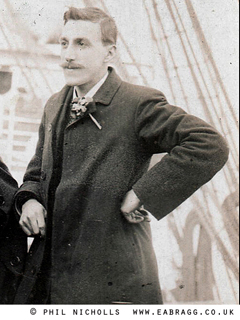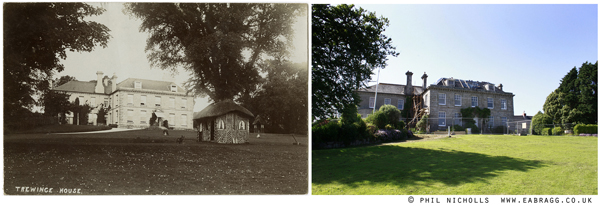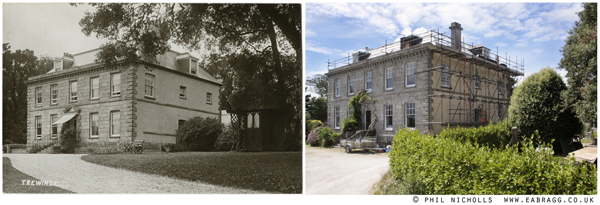EA Bragg photographs Trewince House C. 1910: A Century Later, How’s the Old Place Looking?
 I’ve always loved old portrait-photographs and as a kid would spend hours puzzling over the visage of, perhaps, an ancestor, maybe staring into the eyes of my Great-Great Grandfather. What was he thinking as he looked into the camera, imagine if he had known he would literally be looking through time, right into the eyes of his descendant so many years later? Well, that’s me musing again, that’s how old photographs haunt me!
I’ve always loved old portrait-photographs and as a kid would spend hours puzzling over the visage of, perhaps, an ancestor, maybe staring into the eyes of my Great-Great Grandfather. What was he thinking as he looked into the camera, imagine if he had known he would literally be looking through time, right into the eyes of his descendant so many years later? Well, that’s me musing again, that’s how old photographs haunt me!
Houses, landscapes and seascapes; well, that’s another matter. We can actually go out and compare ‘then and now’. The exceptional quality of early photography gives us a real glimpse of our surroundings as they were, in the case of Edward Bragg, around a hundred years ago. His views were shot on glass-plate and hand-printed on a glossy emulsion. The end product of this particular process is a series of pin-sharp, real-photograph postcards. A digital copy via hi-resolution scan can really feel like one of those ‘Windows in time’ that I often talk about here, one can zoom right into the view.
Over recent years I’ve been locating areas of The Roseland Peninsula that were regularly photographed by Edward Bragg and have tried to capture these places as they are today. Trewince is one of my favourite spots, probably visited on a number of occasions by Edward between 1907 and 1910. He photographed the house from various angles; he recorded a scout troop posing with the squire, and, my favourite, the eagles at the entrance gate.
I bet most of us are familiar with the stone eagles at Trewince and barely give them a second glance these days. I paid a visit to the spot last summer to re-create a bizarre image by EAB that shows a little dog dashing between these eagle-topped gateposts. It took a moment to realise that these winged-creatures no longer face each other but now face outwards – there’s a story here and thanks again to Hilary Thompson for explaining what had happened:
The Hobbs family, who lived at Trewince in the early 17th century, bore arms that included an eagle. The present house, and presumably the gateposts, was built for Stephen Johns, who had married Abigail Hobbs, in the mid-eighteenth century. This would be the date of the eagles. During World War 1 it is said that soldiers returning to St Anthony fort after drinking at Gerrans defaced the eagles, regarding them as symbols of Germany. They were restored some time during the last century by one of the later owners of Trewince.
A week ago I photographed the steps and door at the front of Trewince House where, from this spot, over a century ago, Edward Bragg captured a rather stern looking Squire Thomas seated before the local scout troop. My Grandfather is in the second row from the back and sadly I was never able to ask if he remembered this moment. I often find myself looking at the image and trying to feel my way into the captured moment, trying to see from the scouts’ perspective – go on, why don’t you give it a go?
All attention is on the photographer; it’s very quiet, the flags are blowing in a breeze that carries the scent of the surrounding woodland; perhaps the freshly cut grass on the well manicured lawn perfumes the air; we know the view beyond, the view the scouts are gazing at; a few paces away Edward stands at a tripod directing the moment, can you conjure up your own vision of the scene? I believe we can take a lot more from our treasured photographs with this way of ‘viewing’, it’s a kind of personal interpretation and I hope I haven’t lost you at this point!
The last couple of re-creations are of the house, unsurprisingly little has changed here; paths meander along a different course, trees have been felled, trees have grown, chalets fill the surrounding area, but, essentially the windows of Trewince Manor gaze out upon a scene little changed in Centuries. Today work progresses on a fabulous and historic building and I shall return here over coming months to locate and re-shoot Edward Bragg’s images taken from the surrounding fields, Trewince Quay and Froe Creek. Please return next month to see more of my captures of Edward’s tranquil pre-war images of this area.
Please continue to visit www.eabragg.co.uk and of course ea bragg photographer on facebook to see updates on my quest to tell the story of this ‘Master Photographer’ who fell in The First World War.
Phil Nicholls, August’14.
Portfolio: www.philnicholls.co.uk
Archive & print sales: www.philnicholls.com






Hi Phil.
What a wonderful article, such a joy to read. It shows your talent for expressive writing and enthusiasm of subject. It could only have been written by a photographer with such an appreciation of another’s work.
Thanks keith, yes, there is an appreciation.
keep coming back as there are lots more re-creations in progress – shot some Froe House pics yesterday and just happened upon the same lighting conditions that Edward experienced on one particular day he visited the place. I was so aware of identical reflections in the pool beneath the house, it was another of those haunting experiences, musing on the passage of time. You ought to come out with me on a re-shoot sometime!
Regards, Phil.
What a lovely idea of comparing the old with the new. I was fortunate enough to grow up in the Manor house and now occupy the estate again although in less grand accommodation in the old coach house. My family have collated a lot of old memorabilia from the estate and the former resident Carol Symons has written a wonderful series of books based on the estate. Tremanyon: A shadow falls, depicting a life on the estate when it was a private house. I look forward to seeing more of your work.
Thanks Kathy, I appreciate your comment.
After shooting the steps at the front of the house I really got to thinking about those empty spaces, it’s all quite evocative and I’m working on a series in Helston which will be exhibited at the museum here later in the year – Edward Bragg shot events such as Flora Day in Helston and the empty spaces where the dancers passed, the young men who went to war for instance, that really haunts me. Imagining how such an event would have been after the losses, topical right now too.
I have more re-creations, or re-enactments as I like to call them, of Gerrans and Portscatho plus a set around Trewince Quay and Froe to complete which I must prepare for a local exhibition.
I’ll begin to add all this to the main website soon so please keep a look out as they’ll be much larger on screen.
Thanks again, Phil.